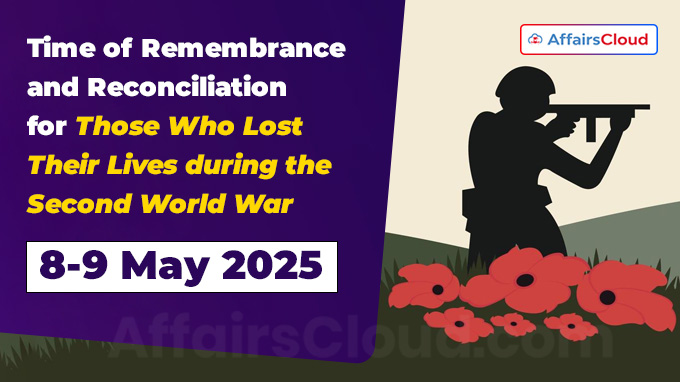 The United Nations (UN)’s Time of Remembrance and Reconciliation for Those Who Lost Their Lives during the Second World War is annually observed across the globe on 8th and 9th of May to honour all victims of the Second World War (WWII) (1939–1945) including around 40 million civilians and 20 million soldiers.
The United Nations (UN)’s Time of Remembrance and Reconciliation for Those Who Lost Their Lives during the Second World War is annually observed across the globe on 8th and 9th of May to honour all victims of the Second World War (WWII) (1939–1945) including around 40 million civilians and 20 million soldiers.
- The day aims to promote global peace & security and encourage reconciliation & dialogue among countries that were once at war.
- 2025 marks the 80th anniversary of the end of the Second World War (WWII).
Significance of the Day:
i.Victory in Europe Day (VE Day) is observed on 8th May, marking Nazi Germany’s unconditional surrender in 1945.
ii.Victory Day, observed on 9th May in Russia and Eastern Europe, recognizes the same event due to time zone differences.
iii.On 8 May 1945, the Allied countries, including the United Kingdom (UK), United States of America (USA), and the Union of Soviet Socialist Republics (USSR), accepted the complete surrender of Nazi Germany, which marked the end of World War II in Europe.
Background:
i.On 22 November 2004, the UN General Assembly (UNGA) adopted the resolution A/RES/59/26 and proclaimed 8-9 May as Time of Remembrance and Reconciliation for Those Who Lost Their Lives during the Second World War.
ii.The resolution encourages UN Member States, organizations, non-governmental organizations (NGOs), and individuals to observe one or both days annually to pay tribute to all victims of WWII.
iii.The first observance of the day was held in 2005, marking the 60th anniversary of the end of WWII and the 60th anniversary of the UN.
Resolution and Commemoration:
i.The UNGA also passed resolution A/RES/64/257 on 2 March 2010 and resolution A/RES/69/267 (2015), reiterating the importance of commemorating WWII victims and promoting human rights, democracy, and reconciliation.
ii.A special ceremonial meeting to mark the 80th anniversary of the Second World War was held on 7 May 2025, as noted in UN resolution A/RES/79/272.
Historical Context of World War II:
i.The WWII began on 1st September 1939 with Nazi Germany’s invasion of Poland and ended on 2nd September 1945 with Japan’s surrender.
ii.It involved the Allies (UK, USSR, USA) and the Axis (Germany, Italy, Japan), causing widespread destruction across Europe, Asia, Russia and North Africa.
iii.There were two surrender signings by Germany to end WWII:
- The first signing took place on 7 May 1945 in Reims, France, where German Colonel General Alfred Jodl signed the surrender on all battlefronts.
- The second signing happened on 8 May 1945 in Berlin, Germany, by German Field Marshal Wilhelm Keitel, as requested by Soviet leader Joseph Stalin.
iv.In 15 August 1945, Victory over Japan Day (V-J Day) marks the day when Imperial Japan surrendered during WWII after the USA dropped atomic bombs on the Japanese cities of Hiroshima and Nagasaki, which led to the end of World War II.
About United Nations (UN):
Secretary-General – António Guterres
Headquarters – New York, the United States of America (USA)
Established – 1945
Member States – 193




